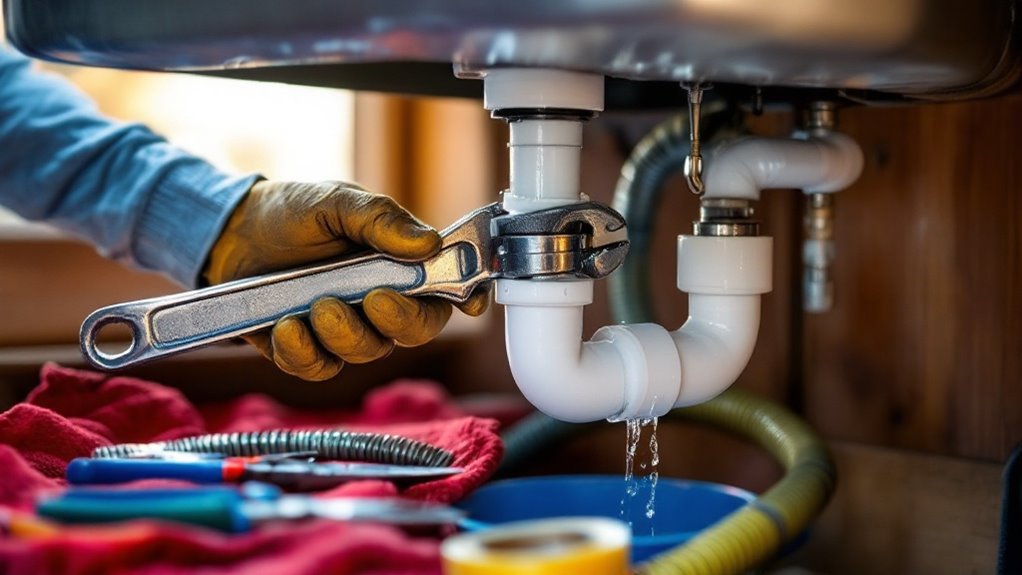Last month, I watched my neighbor shell out $200 for a plumber to fix a clogged drain that I could’ve cleared in 15 minutes with basic tools. It’s a common scenario I’ve seen play out countless times – homeowners spending their hard-earned money on plumbing repairs they could handle themselves. I’ve saved thousands over the years by tackling my own plumbing issues, and I’m not even particularly handy. With the right tools and knowledge, you’ll be surprised at how many plumbing problems you can solve on your own, potentially saving hundreds or even thousands of dollars in service calls.
Basic Tools Every Homeowner Needs
Before diving into complex plumbing repairs, you’ll need to stock your toolbox with essential items that every homeowner should own. Think of it as building your personal plumbing liberation kit – one that’ll free you from those eye-watering service call fees.
Let’s start with the basics: You’ll want an adjustable wrench ($15-20), a set of pliers including channel locks and needle-nose ($25-30), and a quality pipe wrench ($20-25).
Trust me, trying to grip pipes with regular pliers is like trying to eat soup with a fork – technically possible, but really not ideal.
A plunger is non-negotiable, and I recommend getting both a sink plunger and a toilet plunger ($10-15 each).
You’ll also need plumber’s tape ($2), a drain snake ($20-30), and a basin wrench ($15) for those awkward under-sink spaces that seem designed to test your patience.
Don’t forget safety gear! Rubber gloves and safety goggles mightn’t look cool, but neither does an eye full of drain cleaner.
The total investment runs about $120-150, but considering most plumbers charge $75-150 just to show up, you’ll recover these costs quickly.
Common Plumbing Problems and Solutions
Thanks to my years of DIY experience, I’ve found that about 90% of plumbing issues fall into just a handful of common categories: clogged drains, leaky faucets, running toilets, and low water pressure.
Why pay someone $150 per hour when you can tackle these yourself?
Let me share some battle-tested solutions that’ll keep your hard-earned money in your pocket. For clogged drains, start with a plunger or a $20 drain snake before even thinking about those overpriced chemical cleaners.
A leaky faucet? Usually just needs a new washer that costs less than your morning coffee.
Here’s what you’ll need to handle the most common issues:
- Basic pipe wrench and adjustable wrench set ($30-40)
- Quality plunger for both sinks and toilets ($15)
- 25-foot drain auger ($20-25)
- Plumber’s tape and washers ($5)
- Basin wrench for those tough-to-reach spots ($20)
Running toilets are usually just flapper issues – a $5 fix that plumbers love charging $200 to handle.
When to DIY
DIY plumbing projects can save you hundreds, but knowing when to tackle a job yourself versus calling a pro is critical.
I’ve learned through plenty of trial and error that certain jobs are perfect for DIY warriors, while others can turn your home into an unwanted indoor pool.
You’re good to go with DIY when dealing with clogged drains, leaky faucets, running toilets, or simple pipe connections.
These jobs typically require basic tools and less than $50 in materials – why pay a plumber $150 per hour when you can handle it yourself?
But here’s where you need to pump the brakes: anything involving main sewer lines, gas lines, or major pipe relocations should be left to the pros.
Trust me, I’ve seen enough DIY disasters to know that some jobs aren’t worth the risk, no matter how many YouTube tutorials you’ve watched.
Think of plumbing like surgery – changing a bandage is one thing, but you wouldn’t perform your own appendectomy, right?
When in doubt, remember this: if a mistake could flood your house or endanger your family, call the professionals.
Preventive Maintenance Tips
Speaking of avoiding those expensive service calls, I’ve learned that regular maintenance is your best defense against plumbing emergencies.
Why wait until you’re knee-deep in trouble when you can keep your pipes running smoothly with some good old-fashioned preventive care? Trust me, a little effort now saves both money and headaches later.
I’ve developed these battle-tested maintenance tips that’ll help you maintain your plumbing independence and keep those $200-per-hour plumbers at bay:
- Run hot water down drains weekly to dissolve grease buildups – it’s like giving your pipes a free spa treatment.
- Drop a cup of baking soda followed by vinegar down drains monthly, wait 15 minutes, then flush with hot water.
- Check exposed pipes quarterly for condensation or small leaks using a dry paper towel.
- Clean showerheads annually by soaking them overnight in white vinegar.
- Test water pressure using a $12 gauge – anything over 80 PSI means you need a pressure reducer.
Pipe Repair Made Simple
Most pipe repairs come down to three basic problems: leaks, clogs, and pressure issues.
I’ve tackled hundreds of these in my own home, and trust me, you don’t need a $200-per-hour plumber for the basics.
For leaks, I’m a huge fan of epoxy putty – it’s like giving your pipes a band-aid that actually works.
At $5-10 per application, you’re saving serious cash compared to a service call. Just make sure you’ve shut off the water first (learned that one the hard way!).
Clogs? Skip those harsh chemical cleaners that cost $15-20 and eat away at your pipes.
I’ve found that a $30 drain snake and a $5 plumber’s plunger are your best friends.
Want to feel truly self-reliant? Pick up a pipe inspection camera for about $50 – it’s like giving yourself X-ray vision for your plumbing.
Pressure problems usually stem from mineral buildup or trapped air.
I’ve saved countless readers money by teaching them to clean their aerators and bleed their lines.
Emergency Water Shutoff Procedures
Water damage waits for no one, which is why knowing your emergency shutoff points should be step one of home ownership.
I learned this lesson the hard way after a burst pipe turned my basement into an impromptu swimming pool – a $3,000 mistake I could’ve avoided with quicker action.
Let me walk you through the critical spots you’ll need to know, because nothing says “freedom from repair bills” like handling water emergencies yourself.
Your main water shutoff valve is like your home’s panic button – hit it first when things go south.
- Main shutoff valve location: Usually in basement/crawl space near street-facing wall
- Exterior shutoff: Often under a metal cover near your property line (might need a special “key”)
- Individual fixture shutoffs: Under sinks, behind toilets, near washing machine
- Hot water heater shutoffs: Both cold input and hot output valves
- Seasonal outdoor spigot shutoffs: Inside near exterior wall penetrations
Cost-Saving Plumbing Upgrades
Smart plumbing upgrades can slash your long-term costs while putting more control in your hands.
I’ve found that installing a tankless water heater, while pricey upfront ($800-2000), pays for itself within 5-7 years through energy savings of up to 34% annually. Plus, you’ll never run out of hot water again – talk about liberating yourself from the tyranny of cold showers!
Want to stick it to the water company? Low-flow fixtures are your secret weapon. Modern designs give you the same pressure while using 30% less water.
I equipped my whole house with WaterSense-certified faucets and showerheads for under $300, and my water bill dropped like a rock in a drain pipe.
The real game-changer? Installing a whole-house water filtration system ($200-600). Not only will you ditch those overpriced water delivery services, but you’ll also extend the life of your appliances by preventing mineral buildup.
Think of it as giving your plumbing system a suit of armor against the forces of corrosion.
Don’t forget pipe insulation – it’s like giving your pipes a cozy winter jacket for just $50-100 in materials.
You Can Do It Too!
I’ve saved over $800 this year alone by handling basic plumbing issues myself, and you can too! According to HomeAdvisor, the average plumbing service call costs $175-450, but with the right tools and know-how, you’ll be ready to tackle those drips and clogs. Remember, when in doubt, don’t hesitate to call a pro – but for those everyday fixes, you’re now equipped to be your home’s plumbing hero.

